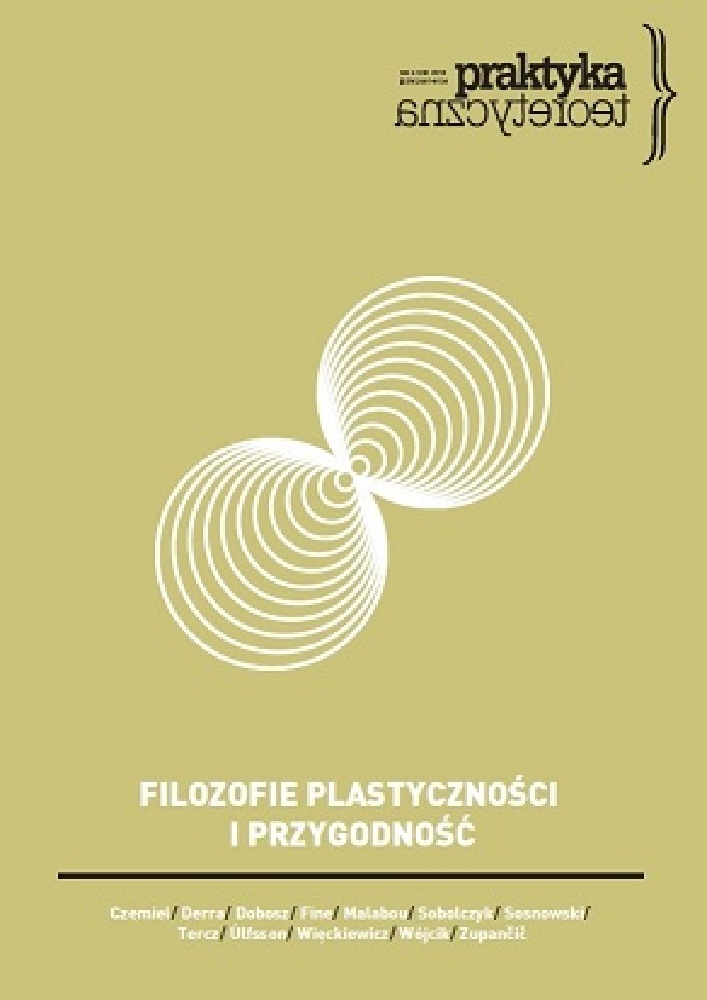Abstrakt
Artykuł poświęcony jest figurze mapy i terytorium w filozofii Catherine Malabou i współczesnej poezji. Problematyzując tradycyjne rozumienie napięcia między mapą a terytorium, Malabou podkreśla fakt, że żadna mapa nie może oderwać się od terytorium, co potwierdza jej analiza tego, jak mózg rozwija się w kontakcie ze środowiskiem. Malabou używa koncepcji kartograficznych opracowując pojęcia “plastyczności” oraz “kartografii świata-mózgu,” które pozwalają ująć to, jak kształtowani jesteśmy przez środowisko, wskazując tym samym sposoby, w jakie możemy wpływać na ten proces. Zastosowanie tej perspektywy do analizy wybranych utworów Elizabeth Bishop i Nigela Forde‟a pozwala ukazać zbieżność poetyk tych autorów z podejściem Malabou i programem teoretycznym ekopoetyki, dając zarazem podstawę do wysunięcia tezy, że poezja dostarcza narzędzi koniecznych do tworzenia lepszych, zrównoważonych “ekologii umysłu”. To zadanie wysuwa się na pierwszy plan w kontekście kryzysu ekologicznego i etycznych wyzwań, jakie niosą ze sobą nastanie epoki antropocenu i rozwój zderegulowanego globalnego kapitalizmu.Bibliografia
Bishop, Elizabeth. 2011. Poems. Edited by Saskia Hamilton. New York: Farrar, Straus and Giroux.
Bristow, Tom. 2015. The Anthropocene Lyric: An Affective Geography of Poetry, Person, Place. New York: Palgrave Macmillan.
Citton, Yves. 2016. “Fictional Attachments and Literary Weavings in the Anthropocene.” New Literary History 47: 309-329.
Fallon, Ann Marie. 2016. Global Crusoe: Comparative Literature, Postcolonial Theory and Transnational Aesthetics. London: Routledge.
Fiedorczuk, Julia & Gerardo Beltrán. 2015. Ekopoetyka/Ecopoética/Ecopoetics. Warsaw: Biblioteka Iberyjska.
Ford, Katie. 2007. “Visibility Is Poor: Elizabeth Bishop‟s Obsessive Imagery and Mystical Unsaying.” Poets.org. April 13, 2007. https://www.poets.org/poetsorg/text/visibilitypoor-elizabeth-bishops-obsessive-imagery-and-mystical-unsaying.
Forde, Nigel. 2003. A Map of the Territory. Manchester: Carcanet.
Guattari, Félix. 2000. The Three Ecologies. Translated by Ian Pindar and Paul Sutton. London: Athlone Press.
Guattari, Félix. 2013. Schizoanalytic Cartographies. Translated by Andrew Goffey. London: Bloomsbury.
Grove, Jairus. 2015. “Something Darkly This Way Comes: The Horror of Plasticity in an Age of Control.” In Plastic Materialities. Politics, Legality, and Metamorphosis in the Work of Catherine Malabou, edited by Brenna Bhandar & Jonathan Goldberg-Hiller, 233-263. Durham: Duke University Press.
Harman, Graham. 2007. “On Vicarious Causation.” Collapse II: 171-206.
Ingold, Tim. 2000. The Perception of the Environment. Essays on Livelihood, Dwelling and Skill. London: Routledge.
King, Geoff. 1996. Mapping Reality. An Exploration of Cultural Cartographies. New York: Palgrave Macmillan.
Malabou, Catherine. 2008. What Should We Do with Our Brain? Translated by Sebastian Rand. New York: Fordham University Press.
Malabou, Catherine. 2010. Plasticity at the Dusk of Writing. Translated by Carolyn Shread. New York: Columbia University Press.
Malabou, Catherine. 2012. Ontology of the Accident. An Essay on Destructive Plasticity. Translated by Carolyn Shread. Cambridge: Polity Press.
Malabou, Catherine & Adrian Johnston. 2013. Self and Emotional Life. Philosophy, Psychoanalysis, and Neuroscience. New York: Columbia University Press.
Malabou, Catherine. 2016. “What is Neuro-Literature?” SubStance 45.2: 78-87.
Malabou, Catherine. 2017. “The Brain of History, or, The Mentality of the Anthropocene.” The South Atlantic Quarterly 116.1: 39-53.
McCardle, Philip. 2004. “Sacred Music.” Review of A Map of the Territory, by Nigel Forde. PN Review 31.1. http://www.pnreview.co.uk/cgi-bin/scribe?item_id=2171.
Palumbo-Liu, David. 2012. “Poetry, Politics, Plasticity, Re-imagination.” Arcade: Literature, the Humanities, & the World, April 20, 2012. http://arcade.stanford.edu/blogs/poetrypolitics-plasticity-re-imagination.
Pickard, Zachariah. 2004. “Natural History and Epiphany: Elizabeth Bishop‟s Darwin Letter.” Twentieth Century Literature 50.3: 268-282.
Twentieth Century Literature 50.3: 268-282.
Reinertsen, Anne B. 2016. Becoming Earth. A Post Human Turn in Educational Discourse Collapsing Nature/Culture Divides. Rotterdam: Sense Publishers.
Silverman, Hugh J. 2010. “Malabou, Plasticity, and the Sculpturing of the Self.” Concentric: Literary and Cultural Studies 36.2: 89-102.
Turchi, Peter. 2004. Maps of the Imagination: The Writer as Cartographer. San Antonio: Trinity University Press.
Vahanian, Noëlle. 2008. “A Conversation with Catherine Malabou.” The Journal for Cultural and Religious Theory 9.1: 1-13.
Licencja
Autorzy:
„Praktyka Teoretyczna” jest pismem, które chce realizować idee wolnego dostępu do wiedzy i poszerzania domeny dobra wspólnego. Ma służyć rozwojowi nauki i krytycznej refleksji w Polsce i na świecie w imię idei wolnego dostępu do wiedzy (Open Access). Całe pismo jest udostępniane za darmo w Internecie na warunkach licencji CC-BY-NC-SA (Uznanie autorstwa-Użycie niekomercyjne-Na tych samych warunkach 4.0 Międzynarodowe) w wersji 4.0 (szczegółowe warunki: http://creativecommons.org/licenses/by-nc-sa/4.0/). Artykuły w nim zamieszczone mogą być dowolnie przechowywane, kopiowane, drukowane, rozpowszechniane i wykorzystywane do celów naukowo-dydaktycznych przy zachowaniu warunków licencji. Apelujemy tylko o uznanie autorstwa i podanie źródła w myśl przyjętych w środowisku naukowym standardów.
Nie ma natomiast możliwości komercyjnego wykorzystania zgromadzonych zasobów bez pisemnej zgody wydawcy. Dostęp do czasopisma nie może być dystrybuowany za opłatą czy w jakikolwiek inny sposób limitowany przez inne podmioty.
Autorzy tekstów przyjętych do publikacji w czasopiśmie „Praktyka Teoretyczna” są zobowiązani do wypełnienia, podpisania i odesłania na adres redakcji umowy o udzielenie nieodpłatnej licencji do utworów, z zobowiązaniem do udzielania sublicencji CC [PL.pdf, PL.doc, EN.pdf, EN.doc].
Zgodnie z umową, autorzy tekstów opublikowanych w czasopiśmie „Praktyka Teoretyczna” udzielają wydawcy czasopisma niewyłącznej i nieodpłatnej licencji oraz zezwalają na użycie sublicencji Creative Commons Uznanie autorstwa-Użycie niekomercyjne-Na tych samych warunkach 4.0 Międzynarodowe (CC-BY-NC-SA 4.0).
Autorzy zachowują prawa do dalszego, swobodnego rozporządzania utworem.
Autorzy nadsyłanych artykułów powinni upewnić się, czy wykorzystywane przez nich materiały nie są chronione prawami autorskimi na rzecz innych osób i ponoszą odpowiedzialność za ewentualne uchybienia w tym względzie.
